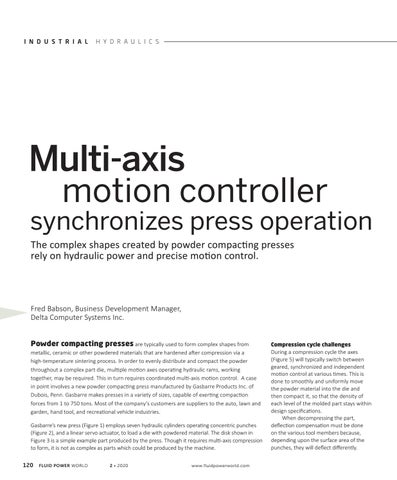I N D U S T R I A L
H Y D R A U L I C S
Multi-axis
motion controller
synchronizes press operation The complex shapes created by powder compacting presses rely on hydraulic power and precise motion control.
Fred Babson, Business Development Manager, Delta Computer Systems Inc. Powder compacting presses are typically used to form complex shapes from
Compression cycle challenges
metallic, ceramic or other powdered materials that are hardened after compression via a high-temperature sintering process. In order to evenly distribute and compact the powder throughout a complex part die, multiple motion axes operating hydraulic rams, working together, may be required. This in turn requires coordinated multi-axis motion control. A case in point involves a new powder compacting press manufactured by Gasbarre Products Inc. of Dubois, Penn. Gasbarre makes presses in a variety of sizes, capable of exerting compaction forces from 1 to 750 tons. Most of the company’s customers are suppliers to the auto, lawn and garden, hand tool, and recreational vehicle industries.
During a compression cycle the axes (Figure 5) will typically switch between geared, synchronized and independent motion control at various times. This is done to smoothly and uniformly move the powder material into the die and then compact it, so that the density of each level of the molded part stays within design specifications. When decompressing the part, deflection compensation must be done on the various tool members because, depending upon the surface area of the punches, they will deflect differently.
Gasbarre’s new press (Figure 1) employs seven hydraulic cylinders operating concentric punches (Figure 2), and a linear servo actuator, to load a die with powdered material. The disk shown in Figure 3 is a simple example part produced by the press. Though it requires multi-axis compression to form, it is not as complex as parts which could be produced by the machine. 120
FLUID POWER WORLD
2 • 2020
www.fluidpowerworld.com




























